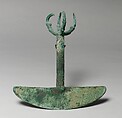Tumi (knife) with a talon
Not on view
The Inca inherited a metalworking tradition that began well over 2,000 years before their rise to power. They brought metalworkers from all over the empire, especially the north coast, to their capital Cuzco, to produce objects in gold, silver, copper, and bronze. Knives, or tumis, were among the most common and widely distributed metal tools produced in Inca times. Typically made of copper or tin bronze, Inca tumis have a long, curved blade at right angles to the handle. The handles could be flat or round, and many have decorated tops. Suspension loops at the top of the shaft suggest they were hung from the belt or necklace.
Tumis were used in ritual sacrifice in the Andes for thousands of years and are frequently seen in artworks in the hands of deities and supernaturals about to perform an act of sacrifice. The knives themselves are often embellished with sacrificial scenes at the top or with elements that refer to sacrifice. On this tumi, the top of the handles bears the massive claws of a powerful bird of prey, the bumpy texture of the shaft being reminiscent of the rough skin of the raptor's legs. The eating habits of raptors and vultures give them a natural symbolic connection to sacrifice and the world of the dead. Textile impressions from burial cover most of the blade's surface.
Due to rights restrictions, this image cannot be enlarged, viewed at full screen, or downloaded.

